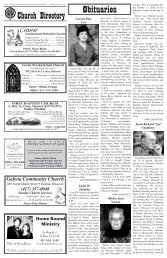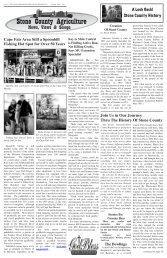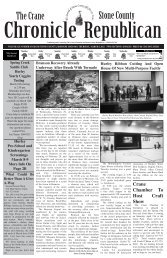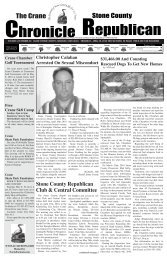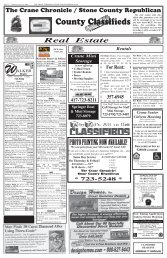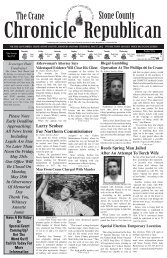Republican Chronicle - Crane Chronicle / Stone County Republican
Republican Chronicle - Crane Chronicle / Stone County Republican
Republican Chronicle - Crane Chronicle / Stone County Republican
You also want an ePaper? Increase the reach of your titles
YUMPU automatically turns print PDFs into web optimized ePapers that Google loves.
Page 8 THE CRANE CHRONICLE/STONE COUNTY REPUBLICAN Thursday, APRIL 15, 2010<br />
Stretching the Food Dollar<br />
By Diane Olson<br />
A small town girl by upbringing<br />
and a bargain hunter by training,<br />
I find shopping an interesting<br />
art and science. Always on<br />
the lookout for a savings, perusing<br />
ads and checking out bargain<br />
racks and tables is a way of life.<br />
In my book, a good sale should<br />
not go unnoticed.<br />
The same shopping passion<br />
carries over to grocery purchases.<br />
Prices in the supermarket rise<br />
and fall, but shopping the sales<br />
and promotions has become my<br />
personal challenge in an effort to<br />
stretch the food dollar.<br />
The First Quarter Market Basket<br />
Survey results show food<br />
prices dropped from this time<br />
last year, but increased over the<br />
last quarter of 2009. This quarterly<br />
survey is a comparison of<br />
prices for 16 common food items<br />
representative across the major<br />
commodities. Shoppers across<br />
the state gathered prices for<br />
these items to create the statewide<br />
average. This number is<br />
forwarded to the American Farm<br />
Bureau Federation for inclusion<br />
in the National totals.<br />
During the first quarter, Missouri<br />
shoppers paid on average<br />
$43.41, compared to $47.40 one<br />
year ago and $42.78 during the<br />
final quarter of 2009. In short,<br />
Missouri prices were $3.99 less<br />
than a year ago and $0.63 more<br />
than last quarter. The national<br />
average for the same items in the<br />
first quarter was $45.54. Show-<br />
Me State shoppers found food<br />
prices $2.13 less than the national<br />
average.<br />
Comparing prices between the<br />
last quarter of 2009 and the first<br />
of 2010 found most meat prices<br />
increased, including sirloin tip<br />
roast, bacon and sliced deli ham.<br />
Decreases in price were found<br />
in ground chuck and chicken<br />
breasts. At the dairy case, milk,<br />
eggs and shredded cheese all<br />
saw increases in price. Produce<br />
prices were up and down with<br />
apples and orange juice ringing<br />
in higher while potatoes and<br />
salad mix were lower. While the<br />
price of flour increased, toasted<br />
oat cereal and bread reported<br />
lower prices. Vegetable oil was<br />
also lower in cost.<br />
The price changes aren’t startling<br />
but rather a slow increase.<br />
According to AFBF Economist<br />
John Anderson, increased food<br />
prices are a sign of a recovering<br />
economy. Despite inconsistencies,<br />
consumers appear to be regaining<br />
normal spending habits<br />
and the food demands are reflected<br />
in the prices. Energy prices<br />
moved higher in the first quarter<br />
to an 18-month high at the end of<br />
March. If this continues to hold,<br />
food prices will likely increase<br />
in the next quarter to compensate<br />
for the additional energy expense<br />
to process and distribute foods.<br />
Tomato Grafting<br />
Workshop in Springfield April 22<br />
A popular workshop on tomato<br />
grafting will be conducted by<br />
University of Missouri Extension<br />
from 7 p.m. to 9 p.m., Thursday,<br />
April 22 at the Hog Barn, Nathanael<br />
Greene Park, 2400 S.<br />
Scenic, Springfield, Mo.<br />
Grafting vegetables to manage<br />
soilborne disease is a simple process<br />
according to Patrick Byers,<br />
horticulture specialist with University<br />
of Missouri Extension.<br />
“Researchers around the world<br />
have demonstrated that grafting<br />
can be effective against a variety<br />
of soilborne fungal, bacterial, viral,<br />
and nematode diseases with<br />
increased yield and keeping fruit<br />
quality,” said Byers.<br />
Byers will teach attendees how<br />
to grafting tomatoes on disease<br />
resistant rootstocks.<br />
The class fee includes tomato<br />
rootstocks, scions of several<br />
heirloom tomatoes, grafting supplies,<br />
and care of the plants following<br />
grafting for each attendee.<br />
Surviving plants may be claimed<br />
seven days after the workshop<br />
according to Byers.<br />
The root stock and scions<br />
for this class will be grown at<br />
Schaffitzel’s Greenhouse, 1771<br />
E Atlantic St, Springfield, Mo.<br />
The class size is limited due to<br />
materials and costs $10 per person.<br />
Register by contacting the<br />
Greene <strong>County</strong> Extension Office<br />
at (417) 862-9284.<br />
2 column x 2 3/4 inch ad<br />
For $23.38 Each Week<br />
This Advertisement<br />
Could Let<br />
Our Readers Know About<br />
Your Business.<br />
“What Have I Done?”<br />
New Work Zone Campaign Aims to Reduce Work Zone Fatalities and Injuries<br />
JEFFERSON CITY – A second<br />
of inattention can lead to a traffic<br />
crash, and when you’re in a work<br />
zone that can cost more than a<br />
fine – it could cost lives. That’s<br />
why the Missouri Department of<br />
Transportation is reminding drivers<br />
not to barrel through work<br />
zones with a new television spot,<br />
called “What Have I Done?”<br />
Road construction season kicks<br />
off this year with Work Zone<br />
Awareness Week April 19-23.<br />
The video features a motorist<br />
after he’s been in a crash in<br />
a work zone – time has seemed<br />
to slow down for him. Moments<br />
before, he was driving along and<br />
calling his family to say he’s<br />
encountered some road work,<br />
but not to worry, because he’ll<br />
“fly right through it.” After getting<br />
out of his vehicle in a daze<br />
he walks over to where he’s hit<br />
something in the work zone and<br />
discovers it’s a person. It ends<br />
with a reminder to all, “Don’t<br />
Barrel Through Work Zones.”<br />
“Every year we try to educate<br />
motorists about the importance of<br />
paying attention and obeying the<br />
signs in work zones,” said Pete<br />
Rahn, MoDOT director. “For the<br />
last couple of years though we’ve<br />
had increases in both work zone<br />
fatalities and injuries, and it’s<br />
time motorists realize how serious<br />
driving errors in work zones<br />
can be for everyone involved.”<br />
In 2009, 13 people were killed<br />
in work zones, an increase from<br />
2008 when 12 people were killed.<br />
There were 670 people injured in<br />
2009 work zones, compared to<br />
599 in 2008. This is an increase<br />
of 11.9 percent. Between 2005<br />
and 2009, 64 people were killed<br />
and 4,260 people were injured<br />
in Missouri work zones. Since<br />
2000, 15 MoDOT employees<br />
have been killed in the line of<br />
duty.<br />
“We need drivers to pay attention<br />
to highway construction and<br />
drive with caution through it to<br />
prevent senseless deaths and injuries,”<br />
Rahn said.<br />
The top five contributing<br />
circumstances for work zone<br />
crashes in 2009 were inattention,<br />
following too closely, improper<br />
lane usage/change, driving too<br />
fast for conditions and failure to<br />
yield - in this order. Of the 878<br />
traffic fatalities in 2009, 693<br />
were vehicle occupant fatalities<br />
and 67 percent of them were not<br />
wearing a seat belt.<br />
“We’re also reminding the<br />
public to rate work zones they’ve<br />
driven through because that firsthand<br />
information will help us<br />
make adjustments and increase<br />
safety for motorists and our<br />
work crews,” Rahn said. To fill<br />
out a Work Zone Customer Survey<br />
and help improve MoDOT<br />
work zones, visit www.modot.<br />
org/workzones/comments.htm.<br />
Besides the new TV spot, Mo-<br />
DOT will remind motorists of<br />
the need to drive safely in work<br />
zones around the state with radio<br />
and internet banner ads, as<br />
well as safety advertisements<br />
on fuel pump tops at various gas<br />
stations and messages on the department’s<br />
changeable message<br />
boards.<br />
More than 250 bridges<br />
are scheduled for construction<br />
this year under MoDOT’s Safe<br />
& Sound Bridge Improvement<br />
Program, a statewide effort to<br />
repair or replace more than 800<br />
of Missouri’s worst bridges by<br />
the end of 2013. Statewide, work<br />
continues on a number of economic<br />
stimulus projects, as well<br />
as the Better Roads, Brighter Future<br />
program that is improving<br />
5,600 miles of roadway by the<br />
end of 2011.<br />
For more information about<br />
construction projects statewide,<br />
look for work zone locations on<br />
MoDOT’s interactive traveler<br />
information map at www.modot.<br />
org or call 888-ASK-MODOT<br />
(275-6636).




